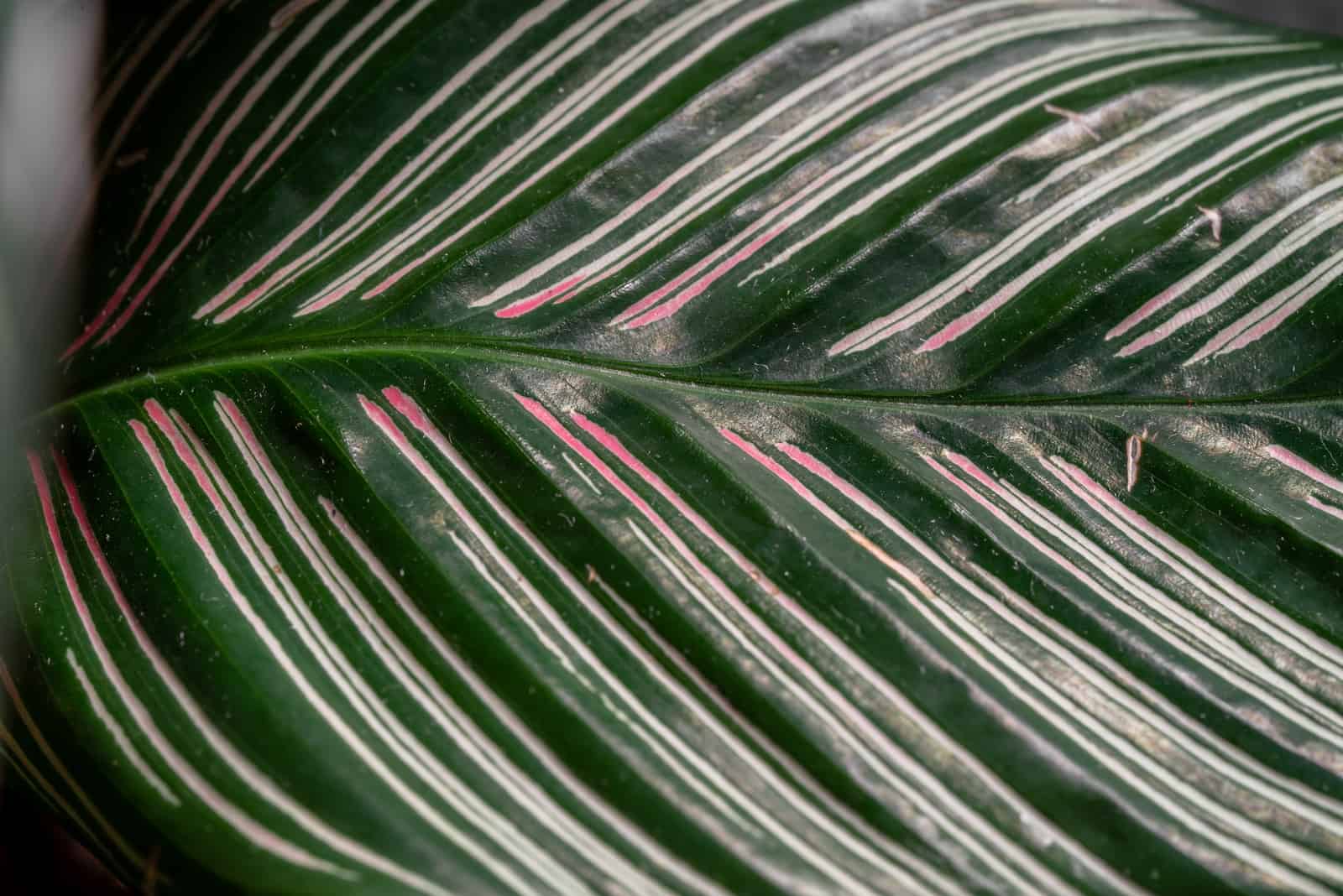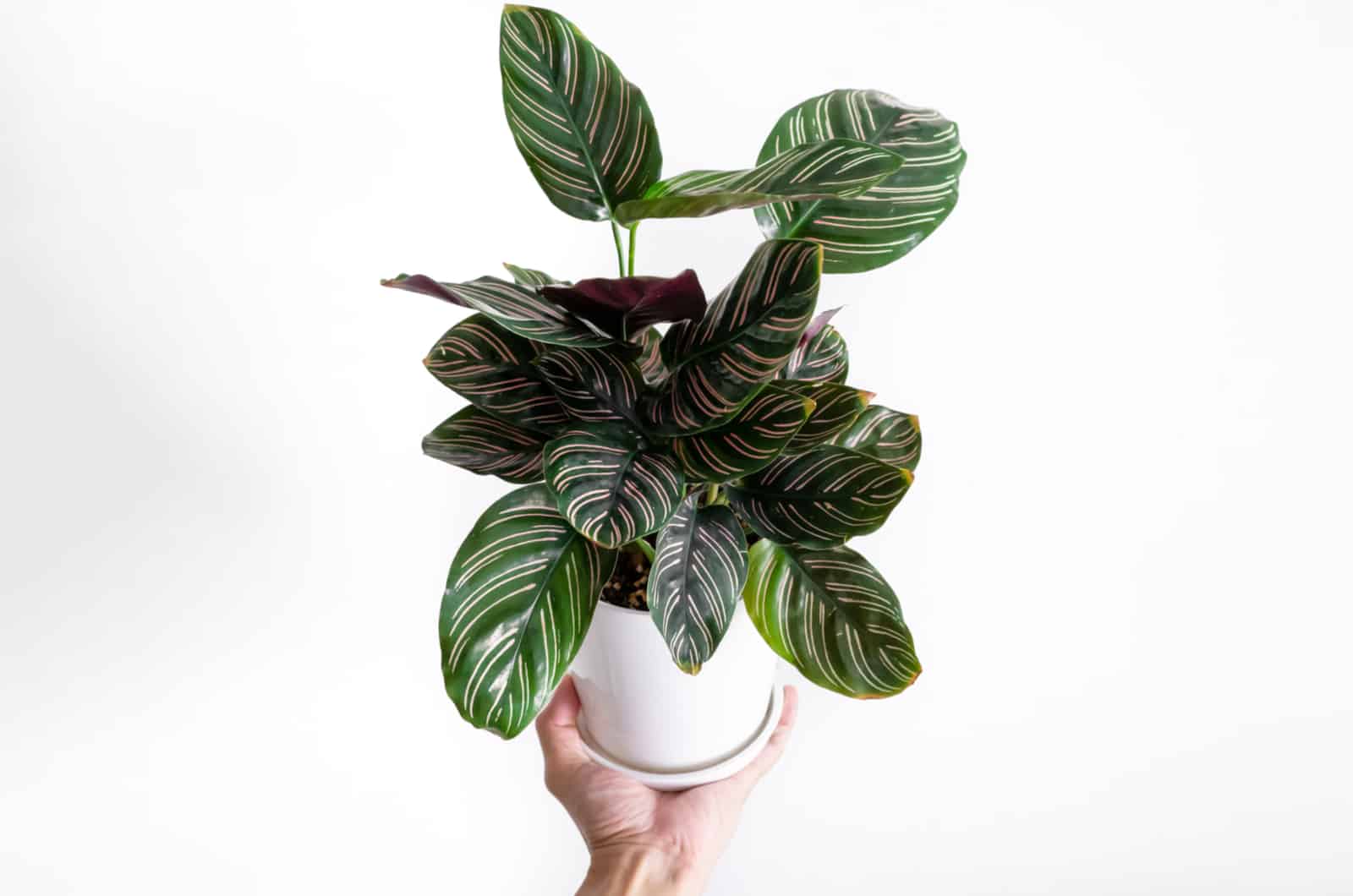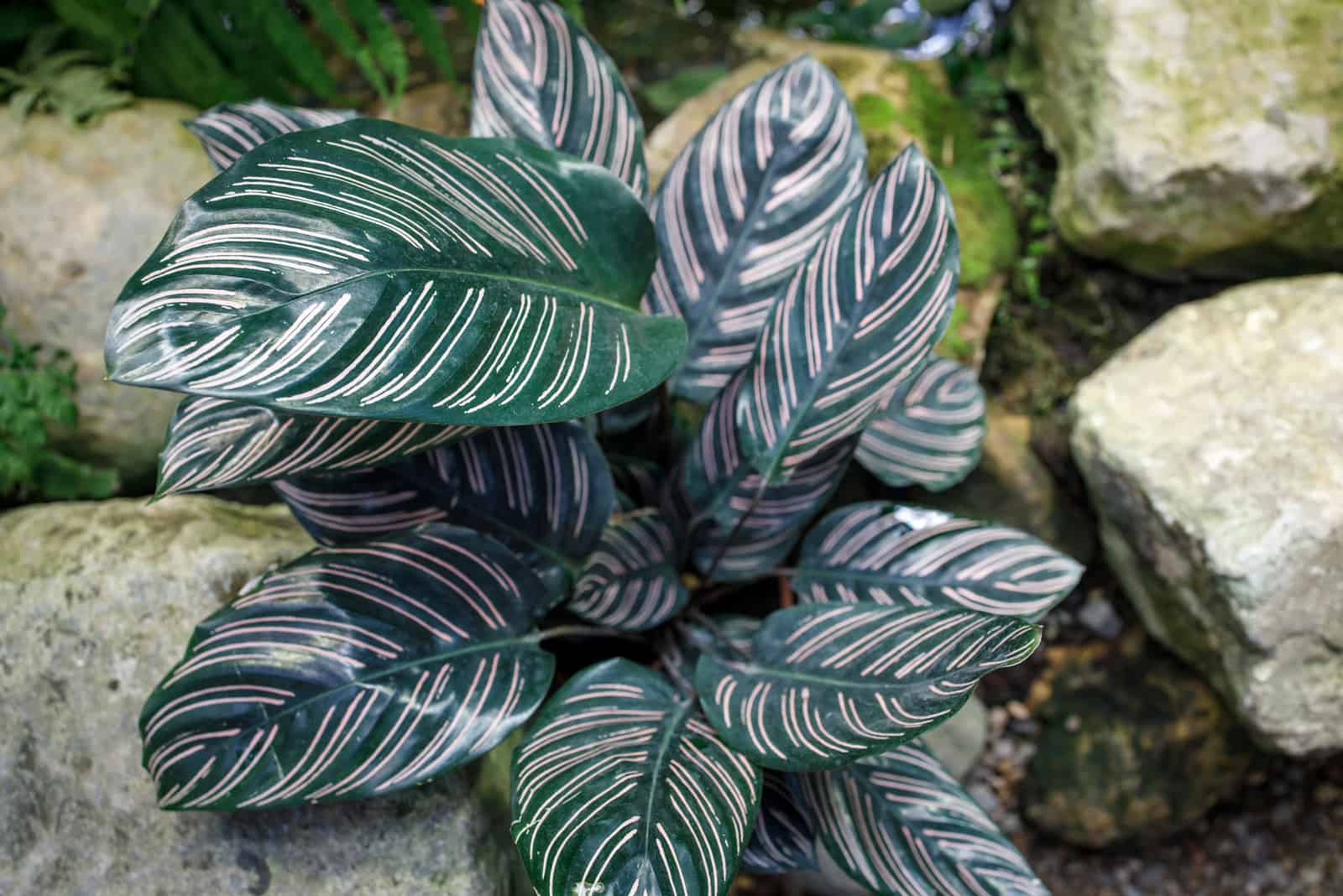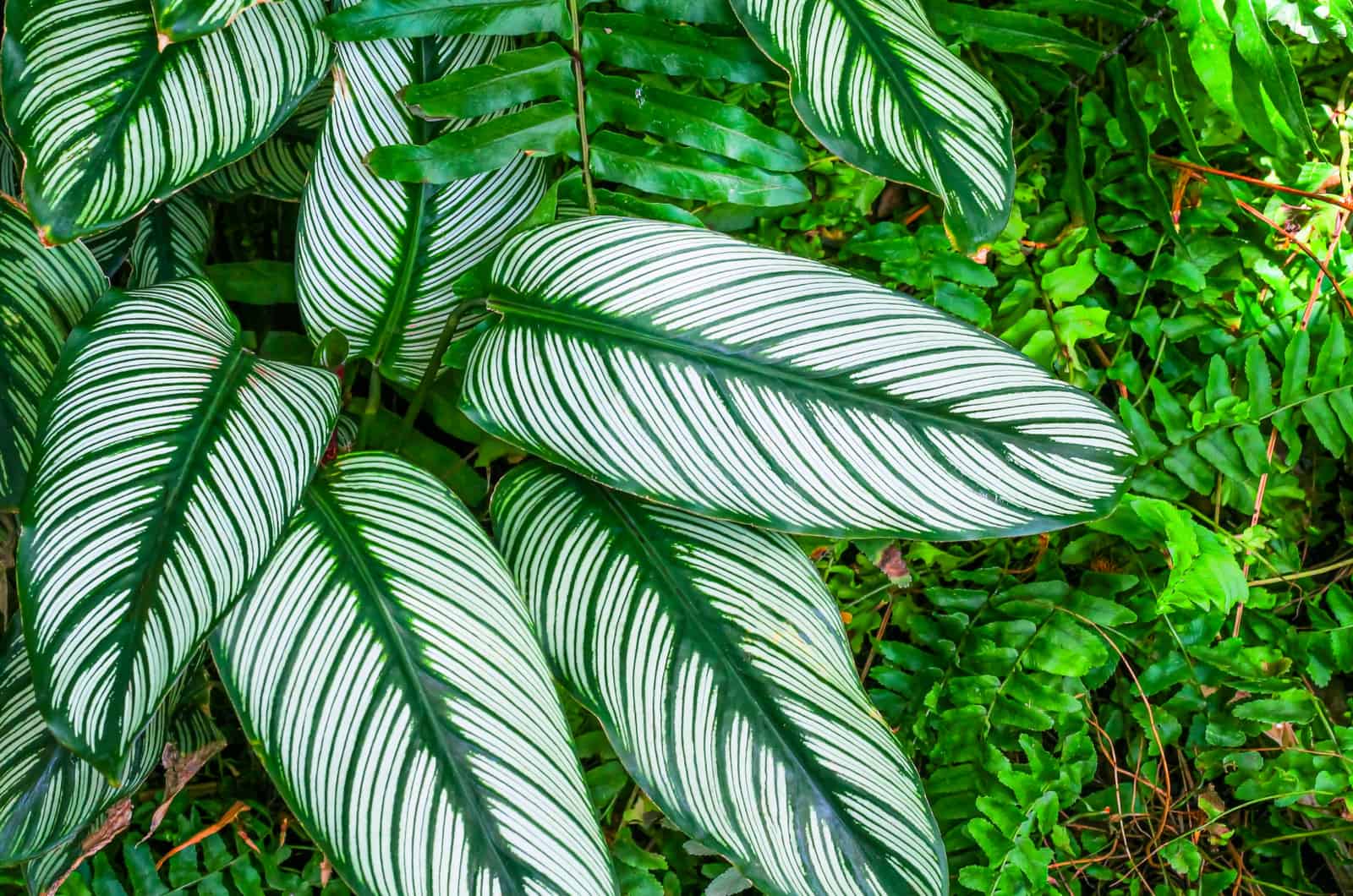Let’s talk about the quirkiest Calathea variety, and that is the Calathea Ornata!
Calathea plants are usually grown as houseplants, mainly due to their unique patterns and stripes on their large leaves. However, the Calathea Ornata differs a bit: it looks like someone took a thin pencil and drew white and pink stripes all over their leaves!
These stripes are lined up in perfect symmetry, and the plant is ideal for minimalist home decor.
This is a type of tropical plant, therefore, it is pretty easy to take care of; you just have to pay close attention to the watering and humidity levels.
Read on if you want to learn more about Calathea Ornata care, and how to deal with certain issues!
Calathea Ornata: Common Features
Pinstripe plant, Zebra plant, Cathedral plant… These are just some common names of the Calathea Ornata, although this plant genus is also referred to as prayer plants, or the Marantaceae family.
We’ve summarized some general information in the table below:
[table id=137 /]This plant originates from tropical regions of Central and South America, Thailand, and Africa. It can grow to about 2 feet wide and tall in proper conditions, which makes it perfect for home decor.
Another feature that definitely contributes to the ornamental purposes of this plant is their oval-shaped leaves, with bright pink stripes contrasting the dark green background. On the underside, the leaves have a purple color.
Subtle, colorful leaves are going to amaze your guests, especially if you practice minimalist home decor.
What is also interesting is that these elegant leaves are going to close overnight and then reopen in the morning — this is a common feature of all Calathea plants, hence the name prayer plants.
The calathea genus has about 300 species; some of the most popular Calathea houseplants are the Calathea Fasciata, Calathea Rosy, Calathea White Fusion, and Calathea Maui Queen.
In addition to their mesmerizing beauty, these plants are capable of purifying the air in your home!
The Calathea Ornata is an evergreen plant, which means that it is going to have those pretty and glossy dark green leaves for a whole year.
One of the most common Calathea Ornata cultivars is the Calathea White Star.
The growing season usually starts in April and ends around October (during this season, you will have to step up your plant care!)
Calathea Ornata: Plant Care Guide
Since they are tropical plants, these plants are used to growing in warm temperatures and humid environments. Usually, the best way to take care of any houseplant is to mimic its natural habitat.
Let’s go step by step through this plant care guide, so we can help to keep your plant happy and healthy throughout the whole year.
You can also check out this video for more tips and tricks:
Soil Requirements
Calathea Ornata plants thrive in well-draining, moist soil. This means that you will have to provide your plant with light potting soil that is also capable of retaining moisture. You can buy a potting mix suitable for Calathea plants, or you can make one yourself!
These are some of the required materials:
• Commercial potting soil is a great base.
• Peat moss and charcoal retain water well.
• Perlite, orchid bark, coco coir, or pumice improve the drainage.
You can combine them differently; I usually do 50% potting soil, 20% charcoal, 20% orchid bark, 10% perlite; or 40% peat moss, 40% perlite, and 20% potting soil.
Air circulation is also essential, so you should avoid heavy soils that are too compact, such as clay soils — the air is not able to reach the roots in these soils, and the soil will slowly suffocate your plant…
Water Requirements
One of the most critical steps in this care guide is the watering routine: since these plants like having moist soil, you will have to water them constantly but not too much, because you might drown your plant.
So, what to do exactly?
The best care tip I can give is to always check the soil before watering: if the surface of the soil is completely dry, then it is time for watering; if it is damp, then postpone watering for a few days.
It is hard to determine a strict watering schedule because other factors like the temperature and humidity also affect the watering needs of your Calathea Ornata plant.
Be careful not to overwater your plant because this might lead to root rot, a dangerous disease that can kill your plant.
Another factor to consider is the type of water you’re using: these plants are extremely sensitive, and any substances or minerals found in tap water might potentially harm them. For example, if there is a high concentration of salt, fluoride, or chlorine, the leaves may begin to turn brown.
There are a few options for dealing with this problem: first, you can filter your water if you have a filtration system. If not, distilled water, or even bottled water, can be used.
Another option is to keep a bowl of water in the refrigerator overnight to allow the chlorine to dissipate; alternatively, you can use rainwater if you live in a location without severe air pollution.
When watering, thoroughly soak the soil and avoid watering the leaves because this can attract pests and insects that could ruin your entire plant.
Light Requirements
Remember that these little plants come from rainforests, so they are used to growing in partially shaded areas.
The Pinstripe Calathea thrives in bright indirect light, though it can also tolerate low light conditions. It would be best to put it near a window that does not get much direct sunlight throughout the day.
Direct light can affect the Calathea leaves and make them curl up and lose their unique stripiness. Not enough light can make your plant look droopy.
I suggest that you place them near an east-facing or north-facing window; if they get too much direct sunlight here, you can put an obstacle in front of the plant to block the light.
Temperature Requirements
Remember that tropical climates are pretty warm; therefore, your plant will grow best in temperatures ranging from 65 to 85 degrees Fahrenheit, though some Calathea varieties can tolerate somewhat lower room temperatures.
Pinstripe Calathea can normally grow at 60 degrees Fahrenheit. However, it is not a fan of temperature fluctuations!
Keeping your plant healthy and alive over the winter can be tricky, since too much heat (from a space heater), and cold drafts from opened windows and doors can cause problems.
Your Calathea plant may be affected by the heat from your computer too, so keep it away from electronics that heat up quickly.
If you want your garden to look more aesthetically pleasing, you can keep it outside — but bear in mind that it will thrive best in hardiness zones 10 to 11. If you live in these regions, I recommend moving your Pinstripe Calathea outside.
If you live somewhere else, you can grow the plant in a container (as a houseplant) and put it outside during the summer. When the temperature drops below 60 degrees Fahrenheit, you should bring it back inside and admire your indoor plant!
Humidity Requirements
High humidity is also a characteristic of tropical regions, and your Calathea Ornata wouldn’t mind growing in higher humidity levels. These types of plants thrive in 75% humidity levels, though they can also tolerate humidity levels of about 50%.
Nonetheless, you should try and do everything you can to keep your plant happy and healthy. Boosting up the humidity levels will give your plant that special humidity glow!
What happens if there is too much dry air in your room? Well, all you will get are curly and crispy leaves!
How To Boost Humidity Levels
1. You can start by misting. Misting is just spraying water on the leaves; it’s a low-cost solution that should be done at least two or three times every week.
2. Another option is not so cost-friendly: you can invest in a humidifier.
3. You can also get creative and build a pebble tray to keep your plant moist: simply arrange pebbles in a tray, fill it with water, then place your plant on top. As the water evaporates, it will provide the moisture that your plant requires.
4. The most simplistic solution is to place the plant in a humid location, such as the bathroom; just make sure your Calathea plant receives adequate indirect light too.
Fertilizer Requirements
It seems that there aren’t many nutrients in tropical regions, as your plant is not a heavy feeder and doesn’t require constant fertilizing!
Nonetheless, you should still invest in a high-quality houseplant fertilizer to promote new growth. Your Calathea Ornata will definitely look much more vibrant and lush if you fertilize it every once in a while.
I suggest that you fertilize it once a month and use a nitrogen-containing fertilizer, since this is an essential nutrient that encourages leaf growth (and your Calathea Ornata is all about its leaves!).
Avoid fertilizing during winter because your plant goes dormant and does not require many nutrients. Overfertilization can lead to a chemical build-up, affecting nutrient uptake and water absorption.
Pruning
This little Calathea plant does not require constant pruning — if it did, then it would definitely be a shame to trim off beautiful, healthy leaves from this plant.
However, you should remove any brown, damaged leaves. If you notice that the leaf edges are browning, you should keep the leaves, as your plant probably has some other issue from which it can quickly recover, and the leaves will soon look as beautiful as ever!
Bear in mind that you should use sterile gardening shears when pruning, and you should also clean the dust off the leaves to keep them looking shiny!
Repotting
The Calathea Ornata is not a fast grower, so you won’t have to repot it every season. You will need to repot it every 2 or 3 years — your plant will tell you when it is time for repotting.
For instance, if you notice any roots coming out of the drainage holes or if the roots are growing above the soil — these two signs indicate that your plant needs more space!
Fortunately, you don’t have to break up with your plant: you just have to repot it!
Early spring is the best time to repot, as it’s before the growth season’s rapid development. To soften the soil and make your job easier, water it thoroughly the day before you repot it.
Purchase a larger pot with a drainage hole in the bottom and prepare the soil; carefully remove your plant from the old pot without injuring the root ball, and voila! Your beloved plant will be successfully replanted!
Calathea varieties are ideal for beginner gardeners because they are not sensitive and can be easily repotted.
Propagation
Calathea plants are hard to find (I’ve been waiting for my Maui Queen for decades!). Therefore, you should definitely propagate your plant and maybe gift it to someone, sell it, or grow it to have two little beauties.
I recommend that you propagate your plant when repotting; this way, your plant won’t suffer from transplant shock twice.
Follow these steps to propagate a Calathea Ornata by root division.
1. First, you should prepare adequate soil for your plant: you can either make your own potting mix, or you can buy it in a local garden shop.
2. Take your Pinstripe Ornata plant out of the pot. If it doesn’t come out quickly, gently tip it onto the side.
3. Gently shake off the roots to remove the soil surrounding them.
4. Select a healthy stem and a few roots.
5. Remove the roots that look damaged or discolored.
6. Isolate the section you want to divide. You can accomplish this with your hands, by carefully separating the root ball from the stem with roots. Because Calathea Ornata is tiny and delicate, you don’t want to harm it, so always use your hands. Alternatively, a sanitized knife can be used. If you don’t want infections to spread, use rubbing alcohol or bleach to sanitize the knife.
7. Place one root section at the center of the soil in the new pot. Add the remaining soil and gently press it down around the roots so the plant stands upright. Do the same with the mother plant.
8. Thoroughly water both parent and baby Calathea plants.
9. Put both pots in bright indirect light.
How To Grow A Calathea Ornata From Seeds
If you buy Calathea Ornata seeds, make sure to follow these instructions for a healthy plant.
1. Fill the pot with your preferred, well-draining soil.
2. Plant the Pinstripe plant seed about 1/4 inch deep in the center of the soil.
3. Place a plastic bag over the pot and puncture tiny holes with a toothpick.
4. Place the seed-filled pot under a bright, indirect light source.
5. It will take about a month for the seeds to sprout.
6. Gently lift the sprout when the seedling reaches about an inch in height. Make sure you don’t put your hands on the roots.
7. Transfer the seedling to a new pot that is at least 2 inches larger than the previous one.
Calathea Ornata: Common Problems
The issues with the leaves are the least enjoyable aspect of caring for this plant. You purchase a Calathea Ornata primarily for its attractive leaves, only to see them turn yellow or curl. What a pity!
We’ll go through some of the issues you might be having with your Calathea Ornata plant if this happens, here.
Leaves Curling And Drooping
Due to some issues, your plant might start looking droopy, or the leaves might begin to curl up. Luckily, these issues can be easily fixed, and your plant will get its glow back in no time!
The common reasons that lead to Calathea curling leaves are inadequate watering and too much light. However, you should check out the rest of this article and see the descriptions of every issue that can cause the curling of the leaves, as well as the solutions!
Asides from the above, your plant might start looking droopy due to the low temperatures.
Leaves Turning Brown
The tips of Calathea Ornata leaves can become brown; the primary cause for this could be low humidity levels. Underwatering, overwatering, tap water, and sunburn could also be reasons for brown leaves appearing.
Your Pinstripe Calathea plant, as described in the care guide, likes moist soil, but you should allow the top of the soil to dry out; however, if you leave it without water for too long, the edges of the leaves may become brown.
You may have met the plant’s watering needs, but you probably used tap water containing chlorine, fluoride, and other chemicals that can harm your plant. Brown leaf tips can be caused by a high salt concentration in the soil. Instead, use distilled or filtered water.
Leaves Turning Yellow
When leaves begin to turn yellow, they do so rapidly. You risk losing your cherished plant if you don’t respond quickly and try to figure out what’s wrong.
Yellow leaves are frequently an indication of poor watering and fertilization, too much direct sunshine exposure, or natural shedding.
Overwatering is a common problem with this plant; you should give it well-draining soil and a pot with drainage holes; if the leaves turn yellow, water it less and move it to a brighter location.
Overfertilization (in this situation, flush the soil with distilled water) or a lack of nutrients and fertilizing might cause fertilizing problems. These plants are not heavy feeders. However, some plant food should be provided.
The plant’s mood determines its natural shedding: if it has recently been repotted, some of the leaves may turn yellow and fall off, or, it may occur naturally as the plant grows and reabsorbs nutrients from lower leaves.
White Stripes
Here, we are not talking about the band, rather than about losing the beautiful pink stripes from the leaves’ surface!
If you set your Calathea Ornata near a window, the stripes are going to lose their color and each whole leaf will look more faded; relocate your plant away from the window and into a low-light location.
But, not too low, as this can result in pattern loss. Too little light can lead to leaves looking faded. Inadequate nutrients could potentially be the culprit too, so buy your plant some plant food right away!
Pests And Diseases
When it comes to taking care of plants, one thing we should constantly keep in mind is pests. These annoyances have the potential to utterly damage your plant and go unnoticed.
They are tiny and barely visible to the naked eye, but they are capable of devouring those gorgeous leaves and absorbing all of their nutrition.
Scales, spider mites, mealybugs, and a fungus that causes root rot can all affect a Calathea Ornata.These microscopic organisms can be challenging to spot, but if you look closely at your plant, you will find different traits that are specific to each particular pest species.
Scales
If you find anything sticky on your plant, you’re probably dealing with scales, which produce sticky honeydew that attracts ants.
Spider Mites
During the winter, if your plant begins to act strangely then it is probably suffering from a spider mites infestation, as they tend to attack during the colder months — leaf showers and increased humidity and moisture levels may prevent them from infiltrating.
Mealybugs
Mealybugs hide in leaves and steal all the tasty nutrients from your plant. Thus, spots on the leaves indicate their presence. The best way to get rid of them is to use neem oil or pesticides.
Root Rot
Root rot has already been mentioned as a common disease caused by excessive watering and poor soil drainage. Root rot is fatal to your plant, so if the soil begins to stink, you must act quickly to save the plant.
If your plant has root rot, repotting it is the best solution: remove it from the infected soil, cut out the damaged roots, and repot it in a new pot. Keep in mind though, that the pot should have drainage holes and that you should use adequate soil.
Frequently Asked Questions
1. What is the lifespan of a Calathea Ornata?
This tropical plant is not a fast grower, and it will take a few years to reach full maturity. The Calathea Ornata can live for up to 70 years in optimal conditions. However, if you provide your plant with poor conditions, especially low temperatures and inadequate watering, then it will most likely deteriorate sooner.
2. Are Calathea Ornata hard to care for?
In my opinion, no. We just have to take into consideration that this plant is of tropical origin and that it should grow in warm temperatures and higher humidity levels. It also requires constantly moist soil, so it should be watered frequently.
This plant is not a heavy feeder, so you won’t have to worry about fertilizing that much. In terms of problems, it is susceptible to some pests, though you can easily get rid of them. You should be on the lookout for root rot, as this is linked to watering habits.
3. How big does a Calathea Ornata grow?
Its growth habits differ when it is grown either indoors or outdoors. For instance, if it is growing in a rainforest, it can reach up to 9 feet tall! On the contrary, it can only grow up to 2 feet tall when it is grown indoors — this is because your plant adapts to its containers, and it will grow according to the provided space.
Final Thoughts
Although this Calathea variety requires special care, I believe it is well worth growing because the pink stripes are so simple, yet so unique, which makes them the perfect addition to any minimalist home decor.
Remember that watering is the most difficult aspect of the care guide, and that your plant cannot handle water stress, so it’s critical to start with an appropriate watering schedule.
If you don’t, you’ll have to save your plant from a variety of problems… but it’s possible!
Remember that poor watering is the primary cause of leaf discoloration and structure changes, and that your Calathea Ornata is prone to various pest infestations. However, you can easily get back on track and continue with the proper care.
Until next time!
Like this post? Share or pin it for later!





